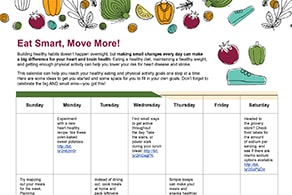Educational Materials for Health Professionals
The following list of materials and websites was developed by CDC for public health and health care professionals. For our list of patient education materials, visit Educational Materials for Patients.
Heart Disease
Stroke
- Cardiac Rehabilitation At A Glance
- Morbidity and Mortality Weekly Reports About Stroke
- Stroke Facts
- Stroke Maps and Data Sources
- Stroke Statistical Reports
Cholesterol
- High Cholesterol Facts
- High Cholesterol Maps and Data Sources
- High Cholesterol Statistical Reports for Health Professionals
- Morbidity and Mortality Weekly Reports About Cholesterol
Hypertension (High Blood Pressure)
- Facts About Hypertension
- Hypertension Communications Kit
- Hypertension Maps and Data Sources
- Improving Medication Adherence Among Patients with Hypertension
Salt

Eat Smart, Move More! [PDF – 934 KB]
This fillable calendar can help your patients reach their healthy eating and physical activity goals one day at a time.

Cardiac rehabilitation (CR) saves lives, but only a portion of eligible patients participate, even after being referred. Quality improvement teams can use the Million Hearts® Cardiac Rehabilitation Change Package to select from a menu of options for specific interventions to improve CR utilization.
Data and Statistics
- Behavioral Risk Factor Surveillance System (BRFSS)
Information about health conditions and behaviors in the United States from the BRFSS, the world’s largest ongoing telephone health survey. - FASTATS
Statistics on public health topics; links to sources of additional data and related Web pages.
Maps
Reports, Guidelines and Recommendations
Guidelines
- Million Hearts® Cholesterol Management Page
This page provides updated cholesterol guidelines and links to treatment protocols and decision aids that can assist clinical teams and their patients in making informed health decisions. - Markers of Inflammation and Cardiovascular Disease: Application to Clinical and Public Health Practice
A Statement for Healthcare Professionals from the Centers for Disease Control and Prevention and the American Heart Association. Published in the journal Circulation. - U.S. Preventive Services Task Force (USPSTF)
An independent panel of experts in primary care and prevention that systematically reviews the evidence of effectiveness and develops recommendations for clinical preventive services. - Guide to Community Preventive Services
The Community Guide summarizes what is known about the effectiveness, economic efficiency, and feasibility of interventions to promote community health and prevent disease.
